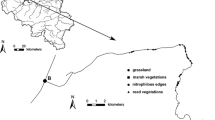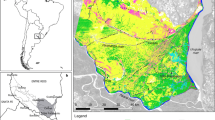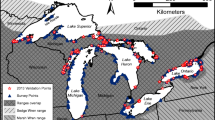Abstract
Strip transects located along roads are commonly used to estimate waterfowl populations and characterize associated wetland habitat. We used data collected in May and early June, 1995, on forty-five 40-km2 plots in North Dakota to evaluate bias of 800-m and 400-m wide roadside transects for sampling wetlands relative to a larger (40-km2) scale and to compare duck abundance at the two widths. Densities of all basins combined and of seasonal basins considered alone were biased high for both transect widths, but mean bias did not differ from zero for temporary or semipermanent basins. Biases did not occur when excavated seasonal and temporary basins (i.e., road ditches) were excluded from the sample. Mean basin density was higher for the inner (400-m) transect width than for the outer transect width (area remaining of the 800-m transect, outside of center 400-m width) for all basins combined and for seasonal and temporary basins. We detected an area-related bias in the occurrence of basins in transects: smaller basins (0.08–1.6 ha) were over-represented in transect samples by 2.9–6.5%, and larger basins (≥11 ha) were under-represented in 800-m transects by 7.3% and in 400-m transects by 16.3%. We compared the distribution of ducks relative to water conditions in the inner and outer transect widths to evaluate whether they were affected by proximity to the road. Mallards (Anas platyrhynchos L.), northern pintails (A. acuta L.), and gadwall (A. strepera L.) responded to water conditions equally in the inner and outer transect widths, but northern shovelers (A. clypeata L.) and blue-winged teal (A. discors L.) responded more strongly to wetlands on the inner than the outer transect width, indicating that estimates of these species would be higher from a 400-m wide transect than from an 800-m wide transect. Differences in an adjustment index, used to account for the portion of basin obscured from view, were highly variable between inner and outer transect widths but did not indicate that use of wider transects was hampered by visibility. Biases of transect sampling need to be carefully considered when extrapolating wetland basin or duck densities from transects to larger landscape scales.
Similar content being viewed by others
Literature cited
Arnold, T. W. 1994. A roadside transect for censusing breeding coots and grebes. Wildlife Society Bulletin 22:437–443.
Austin, J. E., T. K. Buhl, G. R. Guntenspergen, W. Norling, and H. T. Sklebar. 2001. Duck populations as indicators of landscape condition in the prairie pothole region. Environmental Monitoring and Assessment. In Press.
Batt, B. D. J., M. G. Anderson, C. D. Anderson, and F. D. Caswell. 1989. The use of prairie potholes by North American ducks. p. 204–227. In A. Van der Valk (ed.) Northern Prairie Wetlands, Iowa State University Press, Ames, IA, USA.
Cowardin, L. M. and R. J. Blohm. 1992. Breeding population inventories and measures of recruitment. p. 423–445. In B. D. J. Batt, A. D. Afton, M. G. Anderson, C. D. Ankney, D. H. Johnson, J. A. Kadlec, and G. L. Krapu (eds.) Ecology and Management of Breeding Waterfowl. University of Minnesota Press, Minneapolis, MN, USA.
Cowardin, L. M., V. M. Carter, F. C. Golet, and E. T. LaRoe 1979. Classification of wetlands and deepwater habitats of the United States. U.S. Fish and Wildlife Service, Biological Services Program, Washington, DC, USA. FWS/OBS-79/31.
Cowardin, L. M., D. H. Johnson, T. L. Shaffer, and D. W. Sparling. 1988. Applications of a simulation model to decisions in mallard management. U.S. Fish and Wildlife Service Technical Report 17.
Cowardin, L. M., T. L. Shaffer, and P. M. Arnold. 1995. Evaluations of duck habitat and estimation of duck population sizes with a remote-sensing-based system. National Biological Service Biological Science Report 2.
Dzubin, A. 1969. Assessing breeding populations of ducks by ground counts. p. 178–230. In Saskatoon Wetlands Seminar. Canadian Wildlife Service Report Series 6.
Fellows, D. P., and T. K. Buhl. 1995. Research access to privately owned wetland basins in the prairie pothole region of the United States. Wetlands 15: 330–335.
Johnson, R. R., and K. F. Higgins. 1997. Wetland resources of eastern South Dakota. South Dakota State University. Brookings. SD. USA.
Johnson, R. R., and K. F. Higgins. 1998. Bias in quadrat-derived estimates of number of prairie wetlands. Wetlands 18: 329–334.
Johnson, R. R., K. F. Higgins, D. E. Naugle, and J. A. Jenks. 1999. A comparison of sampling techniques to estimate number of wetlands. Wildlife Society Bulletin 27: 103–108.
Johnson, D. H., and T. L. Shaffer. 1987. Are mallards declining in North America? Wildlife Society Bulletin 15: 340–345.
Kantrud, H. A., and R. E. Stewart. 1977. Use of natural basins by breeding waterfowl in North Dakota. Journal of Wildlife Management 41: 243–253.
Kiel, W. H., Jr., A. S. Hawkins, and N. G. Perret. 1972. Waterfowl habitat trends in the aspen parkland of Manitoba. Canadian Wildlife Service Report Series 18.
Millar, J. B. 1981. Evaluation of biases in habitat data collected from roadside transects. Canadian Wildlife Service unpublished report.
Miller, M. R., and D. C. Duncan. 1999. The northern pintail in North America: status and conservation needs of a struggling population. Wildlife Society Bulletin 27: 788–800.
Sauder, D. W., R. L. Linder, R. B. Dahlgren, and W. L. Tucker. 1971. An evaluation of the roadside technique for censusing breeding waterfowl. Journal of Wildlife Management 35: 538–543.
Serie, J. R. and L. M. Cowardin. 1990. Use of social indices to predict reproductive success in canvasbacks. Journal of Wildlife Management 54: 66–72.
U. S. Fish and Wildlife Service and Canadian Wildlife Service. 1987. Standard operating procedures for aerial waterfowl breeding ground population and habitat surveys in North America. Office of Migratory Bird Management. Laurel, MD, USA.
Author information
Authors and Affiliations
Rights and permissions
About this article
Cite this article
Austin, J.E., Sklebar, H.T., Guntenspergen, G.R. et al. Effects of roadside transect width on waterfowl and wetland estimates. Wetlands 20, 660–670 (2000). https://doi.org/10.1672/0277-5212(2000)020[0660:EORTWO]2.0.CO;2
Received:
Revised:
Accepted:
Issue Date:
DOI: https://doi.org/10.1672/0277-5212(2000)020[0660:EORTWO]2.0.CO;2




